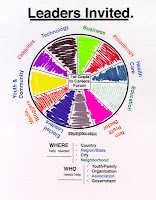"So that's my question: Where are the people, the ones who have the resources and knowledge and networks, who care? Why can't they come together and organize and attack this problem?"
I wish he had been reading this blog for the past 10 years.
 I first used the word ENOUGH to create and share actions people could take, in this 2007 article. I've used it often since then.
I first used the word ENOUGH to create and share actions people could take, in this 2007 article. I've used it often since then.I created this graphic, and versions of it, in the 1990s, to illustrate the need for leaders from every sector to be strategically, and consistently, involved in solving the problems of poverty, inequality, violence, etc. that plague Chicago and many other cities.
Milwaukee is reaping the harvest of that neglect this week.
In yesterday's article I talked about deeper learning and pointed to this strategy map illustrating a commitment that all those people Rex Huppke is referring to, need to be making and keeping.
You need to open and view all of the links at the bottom of each node to really comprehend what this commitment really involves. That's part of the "deeper learning" that has to be part of a path toward a solution.
This isn't a new problem, as this article from 1996 shows. My ideas aren't new either. I've been using maps since 1993 to focus attention, and resource, on neighborhoods with high poverty and poorly performing schools, with the goal of helping well-organized tutor/mentor programs grow in these areas. They just have not been viewed or embraced by very many leaders in Chicago.
Rex said the solution is "not coming from me. I'm a newspaper columnist".
We'll Rex, and others in media, you can be more of the solution than you have been.
Why not use your column to give recognition to leaders who put the strategy map on their web sites, to demonstrate their own commitment. Then look at this 4-part strategy map (it can be found in the links off the middle section of the strategy map.)
 When you give recognition, be specific. Did they do something to improve the information available? Did they use their media, visibility, dollars, to draw more people to the information? Did they appoint someone in their organization to form a learning strategy and lead a company-involvement effort? Do the use maps to show their involvement around places where they do business, or where employees or customers live? Do they provide flexible operating dollars on an on-going basis to multiple organizations. Do they encourage others to duplicate their own efforts?
When you give recognition, be specific. Did they do something to improve the information available? Did they use their media, visibility, dollars, to draw more people to the information? Did they appoint someone in their organization to form a learning strategy and lead a company-involvement effort? Do the use maps to show their involvement around places where they do business, or where employees or customers live? Do they provide flexible operating dollars on an on-going basis to multiple organizations. Do they encourage others to duplicate their own efforts?You can even create maps that show locations of leaders doing good work, or companies, faith groups, hospitals, etc. who adopt and lead this strategy. Host them on your web site, right next to where you keep track of homicides.
Keep doing it, week-after-week. Year-after-year.
Here's a presentation showing how you and others can give recognition to good work, in ways that it is continued and duplicated by others.
Using Ideas to Stimulate Competition and Process Improvement - Concept Paper by Daniel F. Bassill on Scribd
Had reporters been consistently highlighting strategic efforts that make mentor-rich learning programs available in high poverty areas and that help kids come to school better prepared to learn, and leave school with adults helping them in to jobs and careers, for the past 30 years, maybe Chicago would be recognized as a model for social justice, opportunity and where to raise a family, rather than for violence and corruption.
This role is not restricted to media. With social media and the internet anyone can look at this information and give recognition to good work being done in different places. Furthermore, they can connect with each other in on-line communities, like the Connected Learning MOOC #clmooc, and share what they are doing while learning new ideas from peers.
Rex, you could even be writing about that.











No comments:
Post a Comment